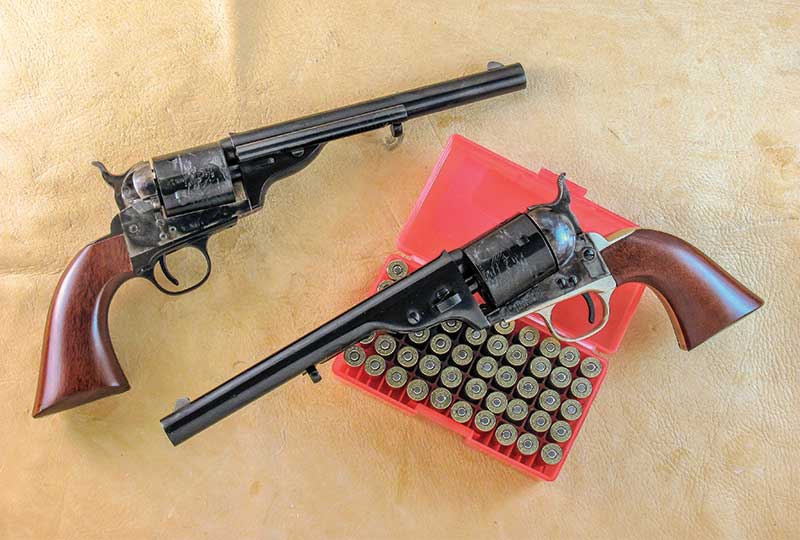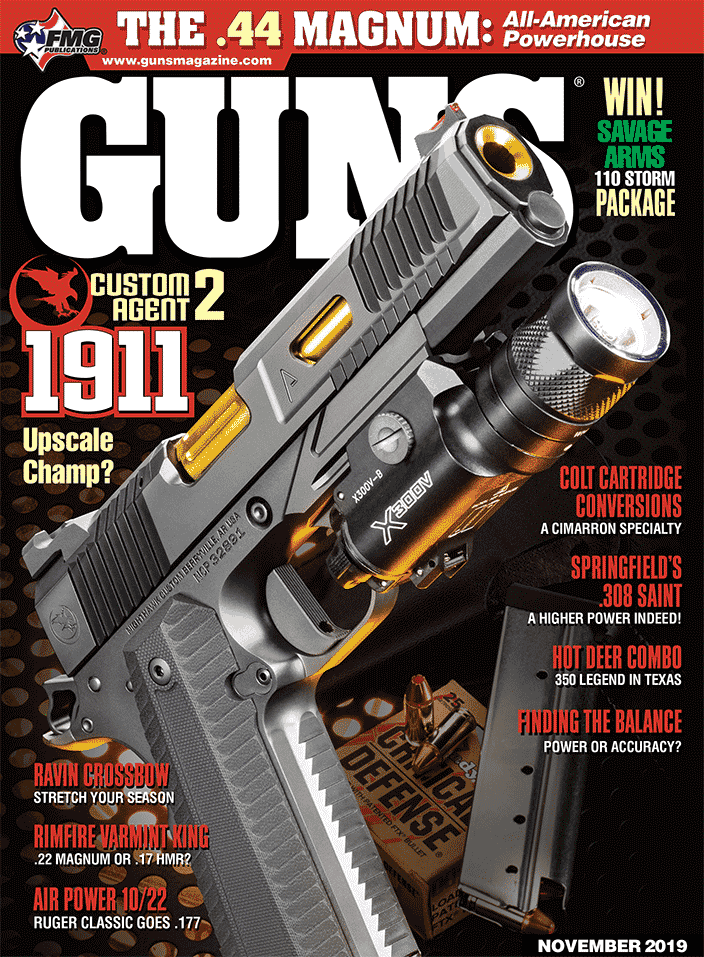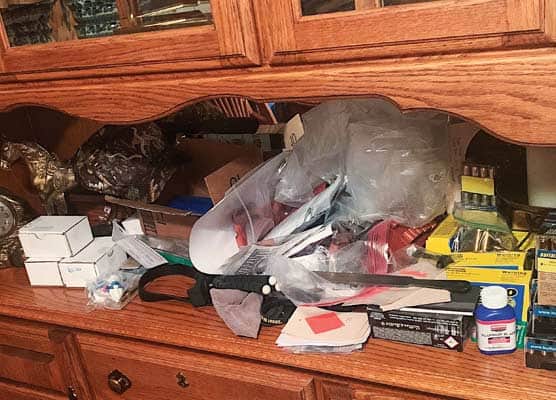Cimarron’s Colt Cartridge Conversions
Technology Transition Frontier-Style
Charles Richards was an assistant factory superintendent at Colt and was awarded three major patents for breech loading firearms, including the Richards Conversion, in 1871. Existing cap and ball cylinders were cut off at the back to allow the installation of a conversion ring to accept cartridges. To complete the conversion, the rammer for seating round balls over the powder charge was removed from beneath the barrel of an 1860 Army and replaced by an ejector rod and housing on the right side for removing spent cartridges.
A loading gate at the rear of the cylinder swung open for loading and unloading. Both civilians and the U.S. Army returned 1860s to the factory to be converted and others were produced as new sixguns at the factory. Among the various conversions, Richards Conversions are recognized by the rear sight on the conversion ring and an ejector rod housing stopping about 1″ in front of the face of the cylinder.
With the arrival of the Second Model Richards conversions, the conversion ring, hammer, and loading gate were all improved, and the Richards-Mason Conversion moved the rear sight to the back of the barrel in front of the cylinder. William Mason was superintendent of the armory at Colt from the mid-1860s until the early 1880s when he moved over to Winchester. He would be responsible for the improvements on the Richards Conversion, the 1871-72 Open-Top, and of course the Colt Single Action Army.
Bridge To The Future
Sixgun history would not be complete without the cartridge conversions as they are the bridge from Colt’s percussion revolvers to the Colt Single Action Army. Conversions were based on the 1860 Colt Army which used a 0.451″ round ball. When the switch was made to a cartridge system, the 1860 Army .44 was chambered for the .44 Colt. The round uses a heel-type bullet, a projectile whose base was smaller in diameter than the rest of the bullet. This results in a bullet the same diameter as the outside of the case, much like today’s .22 rimfire rounds.
The original loading for the .44 Colt was 21 grains of black powder with a thick lube wad between a conical bullet and powder. Bullets weighed approximately 208 grains and muzzle velocity was around 750 fps. The U.S. Army adopted the .44 Colt as one of its official cartridges for two years. When Colt and Smith & Wesson introduced their cartridge-firing sixguns in the early 1870s, thousands of perfectly good cap-and-ball sixguns were still in service. The conversions performed on these revolvers kept many of them shooting right through the turn of the 20th Century.
Replicas are available in the Richards Conversion, Richards-Mason Conversion, and the 1871-72 Open-Top versions, all chambered in a modernized version of the .44 Colt. This “modernized” load was basically a .44 Special trimmed to length. I believe Black Hills was the first to offer modern .44 Colt cartridges in Starline .44 Colt brass. The first .44 Colts from Black Hills were still headstamped .44 Special, but now all .44 Colt brass is properly marked. The replica cartridge conversions had a cylinder too small in diameter to accept six cartridges with the same diameter rim as the .44 Special, so the rims were simply turned to a smaller diameter. Today’s .44 Colt cartridge conversions are available with a larger diameter cylinder so they’ll accept .44 Russian cartridges and some of them are chambered in .44 Special allowing all three .44 cartridges to be used in the same cylinder.
Mike Harvey of Cimarron Firearms and I go way back. I was the first one to write about his replicas and also point out the fact he has worked very hard to have the Italians produce exceptionally authentic replicas — not only authentic in design but also of excellent quality. Cimarron’s offerings have included all three stages of Colt conversions, the Richards, the Richards-Mason, and the 1871-72 Open-Top. I’ve been shooting conversion replicas ever since they first began nearly 40 years ago. Currently, I am using two relatively new Cimarron conversions.
Framing The Difference
These two recent Richards-Mason conversions are basically identical except for the grip frames. The Army Model has a steel 1860 grip frame while the Navy Model has the 1851 Navy brass grip frame. The latter grip frame became the standard Colt Single Action Army frame. Both examples have 7-1/2″ barrels, are very nicely finished with a deep blue, have smooth actions and lock up tightly. Although they’ll handle all three of the .44 cartridges I’ve mentioned, I only use them with the two cartridges from the same era as the original conversions — the .44 Colt and .44 Russian. The .44 Special is one of my all-time favorites, however, I prefer to use it in sixguns which have arrived since it first saw the light of day in 1907/1908.
My most-used powders in loading .44 Russian and .44 Colt for use in these conversions are Red Dot and Clays. I mainly use Oregon Trail Round-Nosed Flat Point (RNFP) cast bullets. The 200- and 225-gr. over 3.5 grains of Red Dot at 700 and 770 fps respectively in .44 Russian brass — or the 240 over 3.5 grains of Clays at 780 fps — all group in the 1″ range for five shots at 20 yards. Switching to the .44 Colt brass, my most accurate loads are the Oregon Trail 200-gr. RNFP over 4.0 grains Red Dot (725 fps) and the same bullet over 4.0 grains of Clays for the same accuracy and velocity.
With the loads basically duplicating the original black powder loads, these Richards-Mason cartridge conversions from Cimarron are pleasant to shoot with minimum felt recoil — they also serve well to transport our sixgunnin’ spirit backwards to the time of the Western Frontier.












